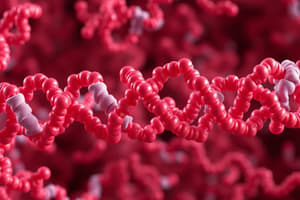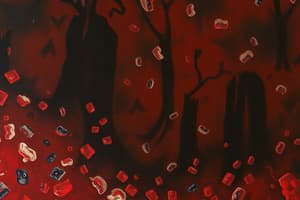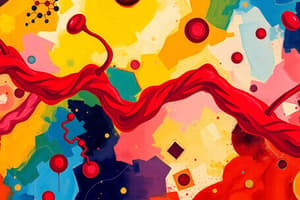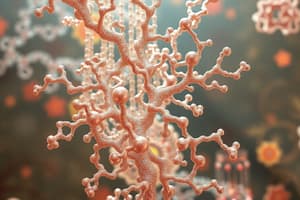Podcast
Questions and Answers
What is the primary function of the iron atom in each haem group of haemoglobin?
What is the primary function of the iron atom in each haem group of haemoglobin?
- To bind oxygen molecules (correct)
- To provide structural support to the polypeptide chains
- To catalyze the breakdown of haemoglobin
- To bind with electrons for energy transfer
Which of the following statements correctly describes a characteristic of haemoglobin?
Which of the following statements correctly describes a characteristic of haemoglobin?
- It consists of three polypeptide chains and a haem group
- It binds to carbon dioxide instead of oxygen
- It lacks any iron components
- It exhibits co-operative binding (correct)
How many total binding sites are available on the iron atom in each haem group of haemoglobin?
How many total binding sites are available on the iron atom in each haem group of haemoglobin?
- 4 binding sites
- 5 binding sites
- 6 binding sites (correct)
- 7 binding sites
Which type of haemoglobin is most commonly discussed in the context of normal physiology?
Which type of haemoglobin is most commonly discussed in the context of normal physiology?
What aspect of haemoglobin is primarily affected in anaemia?
What aspect of haemoglobin is primarily affected in anaemia?
What defines anaemia in men according to the World Health Organization?
What defines anaemia in men according to the World Health Organization?
Which type of haemoglobinopathy involves chains produced in decreased amounts?
Which type of haemoglobinopathy involves chains produced in decreased amounts?
What is a consequence of sickle cell disease?
What is a consequence of sickle cell disease?
Which haemoglobin variant is characterized by a single amino acid substitution?
Which haemoglobin variant is characterized by a single amino acid substitution?
What was the RBC count in the provided case study?
What was the RBC count in the provided case study?
What is the significance of the sickle cell trait in individuals?
What is the significance of the sickle cell trait in individuals?
What is the MCV value indicative of microcytic anaemia in the case study?
What is the MCV value indicative of microcytic anaemia in the case study?
What might pale skin in a patient indicate?
What might pale skin in a patient indicate?
What is the primary function of haemoglobin in the blood?
What is the primary function of haemoglobin in the blood?
Which type of haemoglobin makes up the majority of adult haemoglobin?
Which type of haemoglobin makes up the majority of adult haemoglobin?
How much oxygen can 1 gram of haemoglobin carry?
How much oxygen can 1 gram of haemoglobin carry?
What is the significance of cooperative binding in haemoglobin?
What is the significance of cooperative binding in haemoglobin?
Which type of haemoglobin has the highest affinity for oxygen?
Which type of haemoglobin has the highest affinity for oxygen?
At what oxygen saturation level are the haem groups in haemoglobin fully occupied by oxygen?
At what oxygen saturation level are the haem groups in haemoglobin fully occupied by oxygen?
What is the role of the Gower-1 and Gower-2 embryonic haemoglobins?
What is the role of the Gower-1 and Gower-2 embryonic haemoglobins?
Which statement best describes deoxyhaemoglobin?
Which statement best describes deoxyhaemoglobin?
Flashcards
What is Haemoglobin?
What is Haemoglobin?
Haemoglobin is a protein found in red blood cells that carries oxygen from the lungs to the body's tissues.
What are the components of Haemoglobin?
What are the components of Haemoglobin?
A haemoglobin molecule consists of four polypeptide chains, each bound to a haem group. Each haem group contains an iron atom.
How does oxygen bind to Haemoglobin?
How does oxygen bind to Haemoglobin?
Oxygen binds to the iron atom in the haem group. The iron atom has six binding sites, and oxygen binds to the sixth site.
What is Co-operative Binding?
What is Co-operative Binding?
Signup and view all the flashcards
Why is Co-operative Binding important?
Why is Co-operative Binding important?
Signup and view all the flashcards
Oxyhaemoglobin
Oxyhaemoglobin
Signup and view all the flashcards
Deoxyhaemoglobin
Deoxyhaemoglobin
Signup and view all the flashcards
O2 Saturation
O2 Saturation
Signup and view all the flashcards
Co-operative Binding of O2 by Hb
Co-operative Binding of O2 by Hb
Signup and view all the flashcards
HbA
HbA
Signup and view all the flashcards
HbA2
HbA2
Signup and view all the flashcards
HbF
HbF
Signup and view all the flashcards
Embryonic Hemoglobin
Embryonic Hemoglobin
Signup and view all the flashcards
What is anemia?
What is anemia?
Signup and view all the flashcards
What is a normal hemoglobin level for men?
What is a normal hemoglobin level for men?
Signup and view all the flashcards
What is a normal hemoglobin level for women?
What is a normal hemoglobin level for women?
Signup and view all the flashcards
What are hemoglobinopathies?
What are hemoglobinopathies?
Signup and view all the flashcards
What are the two types of hemoglobinopathies?
What are the two types of hemoglobinopathies?
Signup and view all the flashcards
What is sickle cell anemia?
What is sickle cell anemia?
Signup and view all the flashcards
What are the consequences of sickle cell anemia?
What are the consequences of sickle cell anemia?
Signup and view all the flashcards
What is a possible benefit of sickle cell trait?
What is a possible benefit of sickle cell trait?
Signup and view all the flashcards
Study Notes
Haematology Lecture 3: Haemoglobin
- Haemoglobin (Hb) structure comprises four polypeptide chains, each bound to a haem group. An iron (Fe2+) atom is centrally located in each haem group.
- Hb's function is oxygen transport. Haemoglobin's structure is adapted to loading and unloading oxygen.
- Different types of haemoglobin exist, including HbA (the predominant type in adults), HbA2, and foetal haemoglobin (HbF). HbF has a higher affinity for oxygen than HbA, aiding oxygen transfer from the mother to the foetus.
- Embryonic haemoglobin types (Gower 1 and Gower 2, Portland 1 and Portland 2) are present during foetal development, switching to HbF and then HbA.
- Normal haemoglobin levels vary between men (7.7 mmol/L or 13 g/dL) and women (7.4 mmol/L or 12 g/dL).
- Haemoglobin abnormalities, including haemoglobinopathies, can lead to conditions like anaemia and reduced oxygen-carrying capacity. An example of a significant haemoglobin abnormality is HbS.
- HbS results from a single amino acid substitution (valine for glutamic acid) in the β-globin chain.
- This substitution causes HbS to form long fibrous structures under low oxygen conditions, causing red blood cell sickling.
- Sickle cell trait provides a degree of protection against malaria.
Co-operative Binding
- Binding of one oxygen molecule to haemoglobin increases the affinity of subsequent oxygen molecules for binding.
- This "co-operative binding" maximizes oxygen uptake in the lungs and facilitates oxygen release in tissues.
Haemoglobin Breakdown
- Old or damaged red blood cells (RBCs) are destroyed by macrophages in the spleen.
- Haemoglobin is broken down into its components – globin (amino acids) and haeme.
- Iron from haeme is recycled for new haemoglobin synthesis.
- Biliverdin and then bilirubin (a yellow pigment) are formed from haeme and transported to the liver for processing and excretion in bile.
- Bilirubin build-up can result in jaundice.
Abnormal Haemoglobin Production: Haemoglobinopathies
- Approximately 5% of the global population carries globin variants.
- Inherited disorders often lead to abnormal haemoglobin production (e.g. thalassemias, HbC, HbE).
- Thalassemia is characterized by reduced or absent production of either α- or β-globin chains.
- Other abnormal polypeptide chains like HbC, E, I, J, S are also present.
Case Study (Example)
- A 75-year-old female presented with shortness of breath and fatigue.
- Physical examination revealed pale skin.
- Complete blood count (CBC) results: RBC 3.71 x 1012/L, HGB 5.9 g/dL, HCT 20.9%, MCV 56.2 fL, MCH 15.9 pg, MCHC 28.3 g/dL, WBC 5.9 x 109/L, Neutrophils 82%, Lymphocytes 13%, Monocytes 1%, Eosinophils 4%, Basophils 0%, and Platelets 383 x 109/L.
- Iron profile showed low ferritin (<10 ng/mL), serum iron (24 µg/dL), Total Iron Binding Capacity (TIBC) 729 µg/dL, and low transferrin saturation (3%).
Studying That Suits You
Use AI to generate personalized quizzes and flashcards to suit your learning preferences.




